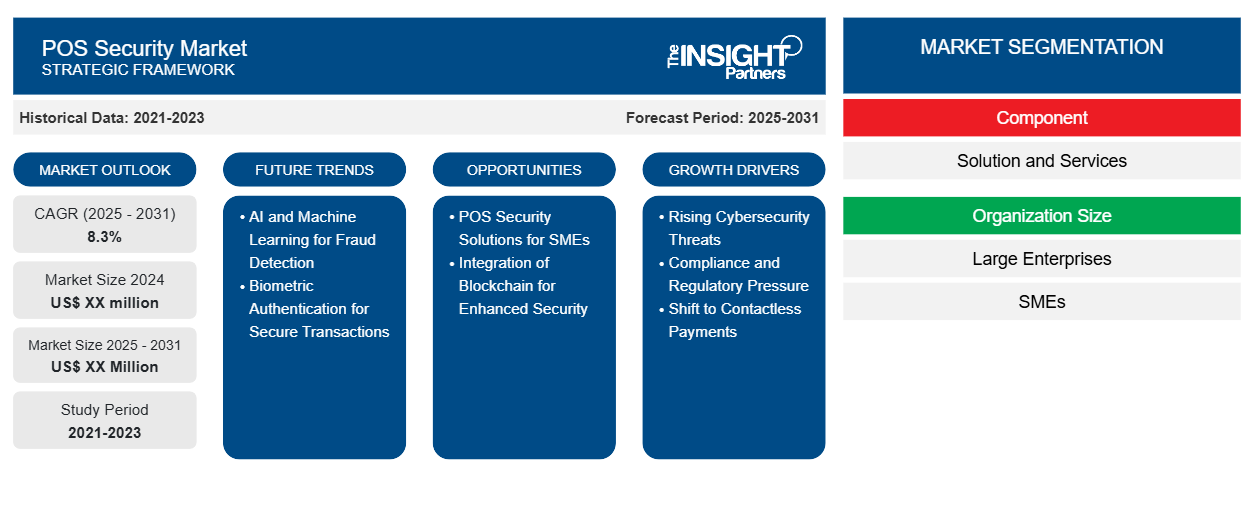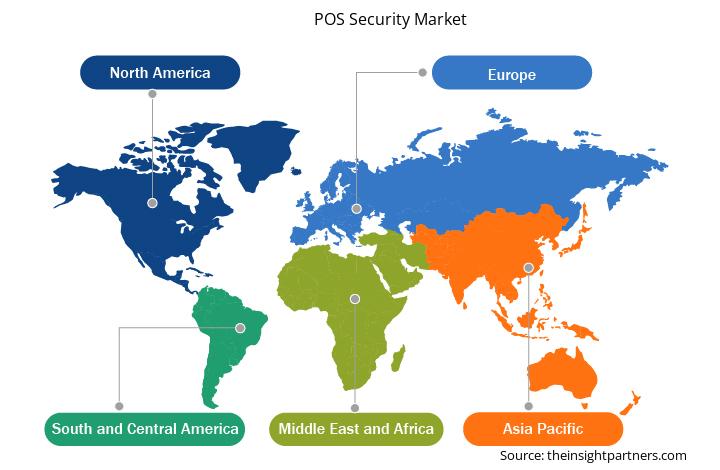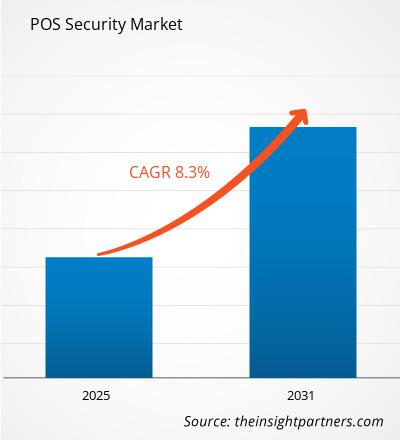预计 POS 安全市场在 2025 年至 2031 年期间的复合年增长率为 8.3%,市场规模将从 2024 年的 XX 百万美元扩大到 2031 年的 XX 百万美元。
该报告按组件(解决方案和服务)、组织规模(大型企业、中小企业)、部署模式(本地部署、云端部署、混合部署)以及最终用户(零售、酒店、银行)进行细分。全球分析进一步细分为区域和主要国家/地区。报告以美元为单位,列出了上述分析和细分市场的价值。
报告目的
Insight Partners 发布的《POS 安全市场》报告旨在描述 POS 安全市场的现状和未来增长、主要驱动因素、挑战和机遇。该报告将为各业务利益相关者提供见解,例如:
- 技术提供商/制造商:了解不断变化的市场动态并了解潜在的增长机会,使他们能够做出明智的战略决策。
- 投资者:对市场增长率、市场财务预测以及整个价值链中存在的机会进行全面的趋势分析。
- 监管机构:规范市场政策和警察活动,旨在最大限度地减少滥用行为,维护投资者的信任和信心,维护市场的完整性和稳定性。
POS安全市场细分
成分
- 解决方案和服务
组织规模
- 大型企业
- 中小企业
部署模式
- 本地部署
- 基于云
- 杂交种
最终用户
- 零售
- 酒店业
- 银行业
定制此报告以满足您的要求
您可以免费定制任何报告,包括本报告的部分内容、国家级分析、Excel 数据包,以及为初创企业和大学提供优惠和折扣
POS安全市场:战略洞察

- 获取此报告的顶级关键市场趋势。此免费样品将包括数据分析,从市场趋势到估计和预测。
POS安全市场增长动力
- 网络安全威胁日益加剧:随着网络攻击的频率和复杂性不断提升,对强大的 POS(销售点)安全系统的需求也日益凸显。黑客以支付系统和客户数据为目标,对企业构成了重大威胁,这推动了对 POS 系统中端到端加密、令牌化和 EMV 芯片技术等先进安全措施的需求。
- 合规与监管压力:PCI-DSS(支付卡行业数据安全标准)等法规正在推动企业部署安全的POS系统。满足这些合规性要求推动了POS安全解决方案的采用,这些解决方案不仅能确保企业合规,还能保护敏感的客户数据免遭泄露。
- 转向非接触式支付:移动钱包和基于NFC的交易等非接触式支付方式的兴起,推动了POS系统对高级安全协议的需求。确保这些非接触式交易的安全需要安全的加密和身份验证技术,以防止欺诈和数据盗窃。
POS安全市场未来趋势
- 人工智能和机器学习在欺诈检测中的应用:人工智能和机器学习与POS安全系统的集成有望彻底改变欺诈检测。这些技术可以实时分析交易模式,识别异常,并在欺诈活动发生之前进行预防。凭借人工智能适应新威胁和从数据中学习的能力,POS系统将随着时间的推移变得更加智能、主动和安全。
- 生物识别身份验证助力安全交易:随着安全问题日益凸显,指纹扫描、面部识别或语音识别等生物识别身份验证正成为 POS 系统的关键趋势。这项技术通过增加额外的身份验证层来增强安全性,降低支付信息被盗的风险,并确保客户交易安全顺畅。
POS安全市场机遇
- 面向中小企业的 POS 安全解决方案:由于预算限制,中小企业 (SME) 往往难以实施全面的安全措施。供应商有机会为中小企业提供经济实惠、可扩展的 POS 安全解决方案。以云端或订阅模式提供这些解决方案,可以让小型企业更轻松地使用,同时确保其符合监管要求并抵御网络威胁。
- 区块链集成增强安全性:区块链技术通过提供不可篡改且透明的交易账本,为增强POS机安全性提供了良好的契机。通过将区块链集成到POS机系统中,企业可以保护交易数据,减少欺诈,并增强客户信任。区块链还可以实现更安全、更高效的跨境支付,为全球零售和电子商务带来新的机遇。
POS安全市场区域洞察
Insight Partners 的分析师已详尽阐述了预测期内影响 POS 安全市场的区域趋势和因素。本节还讨论了北美、欧洲、亚太地区、中东和非洲以及南美和中美洲的 POS 安全市场细分和地域分布。

- 获取 POS 安全市场的区域特定数据
POS安全市场报告范围
| 报告属性 | 细节 |
|---|---|
| 2024年的市场规模 | XX百万美元 |
| 2031年的市场规模 | XX百万美元 |
| 全球复合年增长率(2025-2031) | 8.3% |
| 史料 | 2021-2023 |
| 预测期 | 2025-2031 |
| 涵盖的领域 | 按组件
|
| 覆盖地区和国家 | 北美
|
| 市场领导者和主要公司简介 |
|
POS安全市场参与者密度:了解其对业务动态的影响
POS 安全市场正在快速增长,这得益于终端用户需求的不断增长,而这些需求的驱动因素包括消费者偏好的不断变化、技术进步以及对产品优势的认知度不断提高。随着需求的增长,企业正在扩展产品线,不断创新以满足消费者需求,并抓住新兴趋势,从而进一步推动市场增长。
市场参与者密度是指特定市场或行业内企业或公司的分布情况。它表明特定市场空间内竞争对手(市场参与者)的数量相对于其规模或总市值而言。
在 POS 安全市场运营的主要公司有:
- 甲骨文
- 微焦点
- NCR
- 飞塔
- 惠尔丰
- PayPal
免责声明:以上列出的公司没有按照任何特定顺序排列。

- 获取 POS 安全市场主要参与者概览
主要卖点
- 全面覆盖:该报告全面涵盖了 POS 安全市场的产品、服务、类型和最终用户的分析,提供了整体概况。
- 专家分析:本报告基于对行业专家和分析师的深入了解而编写。
- 最新信息:该报告涵盖了最新信息和数据趋势,确保了业务相关性。
- 定制选项:此报告可以定制以满足特定客户要求并适合业务策略。
因此,POS 安全市场研究报告有助于引领解读和理解行业现状及增长前景。尽管存在一些合理的担忧,但本报告的总体优势往往大于劣势。
- 历史分析(2 年)、基准年、预测(7 年)及复合年增长率
- PEST和SWOT分析
- 市场规模、价值/数量 - 全球、区域、国家
- 行业和竞争格局
- Excel 数据集
近期报告
相关报告
客户评价
购买理由
- 明智的决策
- 了解市场动态
- 竞争分析
- 客户洞察
- 市场预测
- 风险规避
- 战略规划
- 投资论证
- 识别新兴市场
- 优化营销策略
- 提升运营效率
- 顺应监管趋势




















 获取免费样品 - POS安全市场
获取免费样品 - POS安全市场